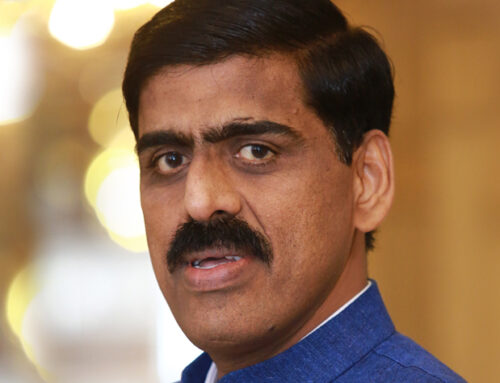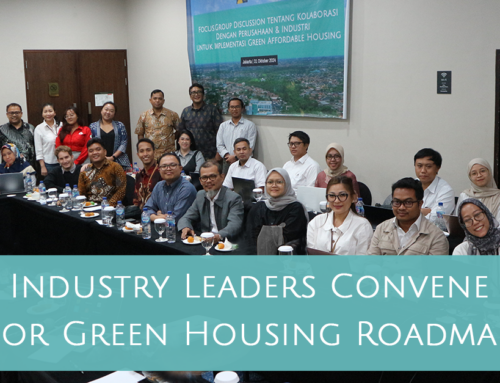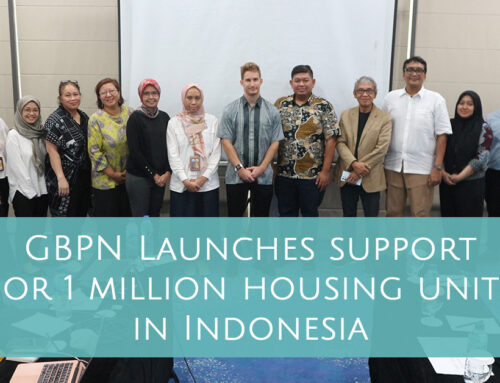Leading by example to create awareness in Indonesia
Dr Jatmika Suryabrata believes that the building sector needs to move faster and more effectively to adopt green buildings. So he decided to lead by example – He has been a member of the Architecture and Planning Board in Jakarta (TABG) since 2013. Dr Jatmika is also engaged with the International Finance Corporation (IFC–World Bank Group) in the development and implementation of Indonesia’s National Green Building Codes as well as Mandatory Building Codes in Jakarta, Bandung, and Semarang. He is an award-winning architect specialising in high performance and green buildings. He has been teaching for over three decades at Gadjah Mada University and hopes that he will be able to generate interest and passion for green buildings in his students with his work.
You’ve been in the green building sector for a long time. How did you get into this sector?
My background is technically in architecture and I specialised in building science. In 2010, I was involved in the design of the Ministry of Public Works headquarter. That was a defining moment in my career, because the Ministry of Public Works is the one that takes care of buildings in Indonesia. And in designing that building we decided to go with a green building concept. So that’s how I got into the green building designing and consultancy. I’m also involved with the IFC in developing developments and implementations of Indonesia’s National Green Building Codes. I’m also practising architectural design in green buildings especially in high performance buildings and thermal comfort etc.
You’ve also been lecturing at Gadjah Mada University. How long has that been? What changes do you see in the awareness of the need for sustainable buildings since then?
I’ve been lecturing at Gadjah Mada since 1986. I graduated in 86, and right away joined as a faculty member, while also doing my masters and PhD.
Before green building regulations started happening in Indonesia, the awareness was quite low. The focus was on aesthetics, and not how it affects the environment. So from when I started in 1986 to 2010, there was hardly any awareness about building performance. Since 2010, when building codes started being developed, there has been a lot of awareness and the building sector is moving in the right direction.
There is definitely a difference from before and after the codes. Policy intervention is a great enabler, and I’m very fortunate and proud to be part of the team that is developing green building codes in Indonesia. I do hope that adoption measures will move faster. People need to understand that green buildings are good for the environment as well as the end user. I was stumped by the inability of the marketing department of a multistorey building to sell energy-efficient flats in one of the design projects I did a few years back.
So, what do you feel are the main challenges for a wider adoption of sustainable buildings?
Awareness at multiple levels. The first is about technical knowledge. Most architects consider themselves as more of artists and less of engineers. So there is less interest in numbers and calculations, like what is the calculations to make the building more energy efficient for residents. Second, is the lack of awareness of the effect of buildings on the environment. There is not enough publicity about what is wrong with our buildings and our cities. And because of this lack of awareness, there is an assumption that green buildings are expensive. They are not, if you know how to do it in the right way.
Very few people have the skill to make calculations about building efficiency. But if you can show the client how much savings can be done by adopting sustainable design or energy-efficiency measures, and show them samples of how it is done in real buildings, they will be more willing to adopt it. I do it every time I propose a design – giving samples, examples, calculations of savings. It can be even simple things, like adopting the right type of air conditioning.
How is GBPN’s work in Indonesia addressing these challenges?
We are going in the right direction with our projects. Working with the government is the most effective and faster way of making adoption of green buildings more common. And that’s why regulations are important at all levels, national, sub-national and local. Another thing that we can do is education – educate architects and developers on how to do calculations and effective adoption of sustainable practices. GBPN is doing programs on that line, and hopefully we can do that massively in the coming years.
GBPN projects lay particular importance on the alignment of sub-national regulations with national regulations.
Yes, that is right. Like I said earlier, we have to move massively in all sectors to get an impact. So working on a national level with different ministries, especially the Ministry of Public Works together with the Ministry of Energy is very important for sustainable development. Sub-national governments also make localised regulations, as long as it doesn’t contradict the national regulations. Then, the implementation happens at the sub-national and local level. So it becomes very important that there is an integration between national and sub-national projects, and GBPN is doing exactly that. We network with ministries and agencies that make building codes on one hand and that are actively involved in implementing the code on the other.
You have been teaching students of architecture and planning for over three decades. What will you say to a student who wants to specialise in green buildings?
I also teach green buildings at the university and I motivate them to develop interest in this speciality. They are seeing me work in the area, and I hope I can set an example for my students on the need, importance and scope for sustainable buildings. One thing I tell them is that you can have green buildings as your trademark because very few architects have the skill to do it properly. So you can have a competitive edge. A green building specialisation is good for your career, there is huge demand and opportunities for the specialisation.
Share This Story, Choose Your Platform!
Stay in touch with how we’re transforming the buildings sector
GBPN runs innovative building policy reform programs in key regions around the world that aim to tackle the climate emergency by decarbonising the buildings sector. Stay up to date with our newsletter.
Stay in touch with how we’re transforming the buildings sector
GBPN runs innovative building policy reform programs in key regions around the world that aim to tackle the climate emergency by decarbonising the buildings sector. Stay up to date with our newsletter.







